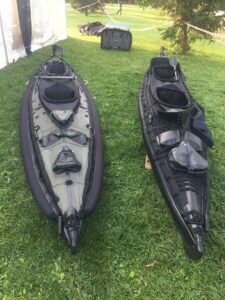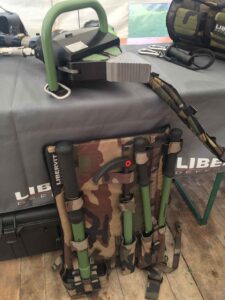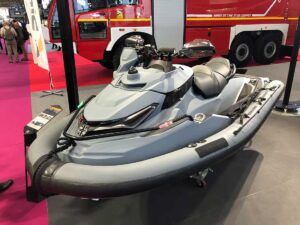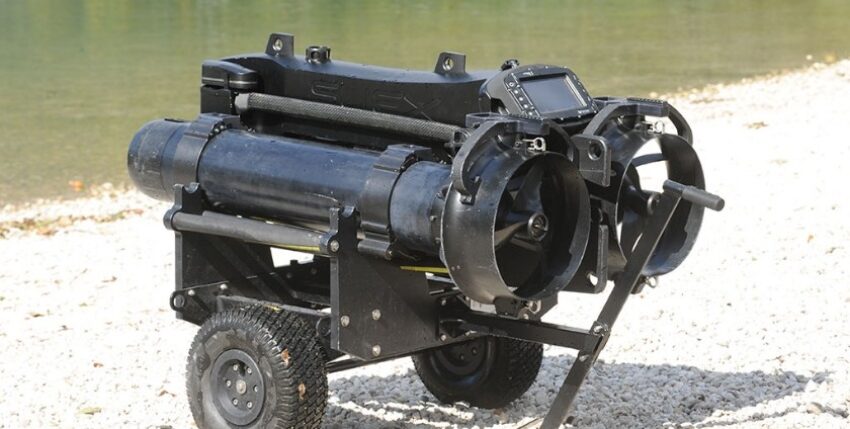Maritime special forces require powerful and innovative equipment to operate efficiently. The industry has a wide range of innovations to offer.
Combat swimmers are special forces that are specially trained to fight in and under water or move over water to fulfil missions on land. They can be easily distinguished from pioneer divers and amphibious special forces such as the German Special Forces Command (KSK) or the American Delta Force, as they are deployed on boats. There are actually only a few new trends and solutions to report when it comes to their personal equipment, although these have been constantly developed further. Rebreathers, which are among the most important items of equipment, are becoming increasingly compact and are being combined with breathing gas monitoring systems. These not only ensure safety during the dive, but also act as a dive logbook. The German company Niebergall has further developed luminescence for military applications, in this case for diving equipment displays. They can now also be read in the dark and do not have to be illuminated first. The Seal Mk 1 Pro from Italy is the most compact and lightest underwater breathing apparatus with a closed oxygen circuit developed and manufactured by Siel for shallow waters and short to medium duration missions.
The approach of the emergency services to the target under or on the water plays a special role, unless they are dropped from the air by helicopter or parachute.

military use, photo: André Forkert
Sillinger from France offers the SRD Sub (Sillinger Rapid Deployment) inflatable boat for this purpose. The design of the Rapid Deployment Boat with a length of between 3.80 and 5.25 metres enables the emergency services to quickly pick up the boat - either from the ground or from a submarine, or to lay it on the ground for camouflage. Thanks to an automatic system, it can be inflated within 45 seconds using a compressed air cylinder. It takes around five minutes to deflate the boat completely and let it sink to the bottom, or to make it ready for use from a depth of 15 metres in the same time. Although the engine is encapsulated watertight, a dry bag has now been added for the engine. But even without this aid, the engine can be lowered to a water depth of up to 15 metres. It has been in use in France for around seven years. The payload is stated as 900 to 1600 kilos, depending on the length of the boat.
Inflatable boats
Maritime Craft Aerial Delivery Systems (MCADS) are used to transport inflatable boats by air and drop them from aircraft. Sillinger works closely with IrvinGQ, which offers platforms designed for this purpose in the form of Atax and Pribad 21.
The German special forces are currently looking for a new combat boat for use on rivers, which can be used for military evacuation operations as well as for tactical operations and direct support of special forces. Procurement is to take place together with the Army Engineer Corps. Until then, the Special Forces Command has a smaller 6-man inflatable boat at its disposal. The accessories for air transport are to follow.
On 22 June, the Budget Committee of the German Bundestag discussed the procurement of new medium-range operational boats for the Navy's Special Forces Command. The procurement can now be initiated. These boats can be accommodated by the frigates 126 and the task force supply vessels and will replace the outdated RHIB H 1010. Nine boats are to be procured with an option for three more. Delivery of the first boats is scheduled for early 2025.
The British Special Boat Service (SBS) is testing a new armoured boat that can travel at 50 knots. The high-speed boat Stormblade from BAE Systems can carry up to six commandos and is unsinkable thanks to its self-righting hull. The SBS can deploy it in counter-terrorism operations on the UK's rivers.
Another platform is the K 50 from the start-up Kraken. This is an extremely powerful maritime platform that can be deployed quickly to deploy forces for the defence of civilian or commercial infrastructure in the maritime sector. Inspired by the efficiency and versatility of heavily armed motorboats in the Second World War, the K 50 is in every respect a worthy successor to the well-known MTB, MGB and PT Boat. The Kraken K 50 was developed from the outset as an integrated weapons platform and surpasses everything currently on the market. It offers high performance and a wide range of deployment and customisation options. This combination of innovative technology, solid construction and high flexibility makes the K 50 equally effective for both defence and attack. The Kraken is available in two variants: K 50A and B. The K 50A is a fully equipped combat boat with extensive armament and unrivalled performance characteristics. The K 50B is designed to meet the needs of naval forces, border troops and law enforcement agencies for intercepting suspicious vessels and for fast patrols. The K 50B is based on the same design philosophy and innovative thinking and can be equipped for specific scenarios. The boat offers exceptional performance and adequate armament combined with unparalleled mission-specific customisation options.

from Libervit, Photo: André Forkert
The inflatable, electrically powered Kraka Jet Board, which was recently developed in Sweden, is significantly smaller. It is very light and takes up very little space when folded, so it can easily be packed into a small jettison container or carried in the torpedo tubes of a submarine. According to the manufacturer Soal Marine, it takes less than three seconds for the device to be fully inflated and ready for use. It then offers the user a simple means of transport to the deployment site. The Kraka can best be compared to an inconspicuous inflatable boat. Both alternatives offer roughly the same advantages, but differ in size and the ability to be air-dropped. The Kraka is manufactured in three sizes and with different orientations: Transport, Air and Dive. The device is well suited for SAR, combat swimmer and infiltration missions. The board is made of lightweight composite and inflatable materials and is built to last. The 11-kilowatt brushless electric motor can propel two commandos, including equipment, at speeds of up to 20 knots. Maintenance requirements are said to be minimal. The battery supplies the drive system with energy for 30 to 60 minutes, depending on the speed and load. Additional batteries increase the range. The Kraka can also be towed by other boats or watercraft. There are three sizes in six variants, each for a payload of 250, 400 or 600 kilograms. In each size, the Kraka is available as a sled vehicle without drive or with the aforementioned electric motor. There is also an optional modification for use as a transport, drop-off or submersible vehicle.
One of the most vulnerable parts of inflatable boats are the outboard motors. After a hit, the drive can fail, making the boat an easy target. For this reason, Falcon Dynamics and its Swedish partner Equipnor have developed ballistic protective covers for outboard engines. These are customised for each engine and protect it from small arms fire.
Electronic defence systems
As radars, thermal imaging devices and electronic defence systems become more widespread, swimmer delivery vehicles (SDVs) are becoming increasingly important to ensure a covert approach. The other important tool for reconnaissance, action and support is the unmanned surface vehicle (USV).
One of the latest SDVs is the Shadow Seal, developed by Filip Jonker and JFD Ortega Submersibles from the Netherlands. The Shadow Seal can carry four fully equipped operators and 450 litres of payload. It offers excellent rolling stability and can also be used in rough seas. The Shadow Seal is designed for both surface and (semi-)underwater transport and has two powerful electric motors. It is equipped with closed-circuit trim tanks, bow and trim thrusters, underwater navigation system, onboard suit heating and CCR compatibility.
Golden Arrow Marine offers a jet ski for military operations. A civilian Seadoo serves as the basis, which is customised according to customer requirements. This turns the commercial off-the-shelf into a modifiable off-the-shelf called the Tactical Water Craft X3. It has an external collar or tube that provides more stability and absorbs shocks when boarding or picking up people from the water. In addition, the Jet Ski has four lifting points for picking up and setting down ships or helicopters, two additional tank pockets to increase the range, protectors on the steering handles, which can also be heated in extremely cold conditions, integrated (military) GPS and a tow rope at the rear for loads. It can therefore now travel faster than 75 knots. There are already several users in NATO and around the world.

Scooter
The Italian manufacturer Suex offers a variety of scooters for diving depths of up to 200 metres. By combining several scooters into one system, up to four divers or heavy loads can be transported over long distances without any problems.
Rotinor from Germany offers the Seabob Black Shadow 730 (RBS) and the smaller DiveJet RD2. Both can be launched via the torpedo tube of a submarine or by parachute. They can be used at depths of up to 60 metres and are therefore ideally suited for all types of underwater missions and special operations. The hydrodynamic design of the RBS gives the submersible scooter a high degree of agility in the water. All steering and diving manoeuvres are performed by shifting the body weight. The specially developed harness system allows the user to control the enormous thrust without any problems. It is powered by an E-Jet motor. Advanced Tactical Airborne Systems and Services (ATASS) offers the Trident and Triton harnesses from Paratec for use with parachutes. These special harnesses enable maritime special forces to safely transport submersibles by air to any desired location. The Trident harness consists of a large bag containing the harness itself, the grid board, the roller unit and the deflation device with V-connections, friction plate with centre strap and deflation line. Both harnesses can carry a payload of up to 115 kilograms.
At the Sofic trade fair in Tampa, Florida, one of the calls was for the US Navy Seals to receive upgrades for their silent underwater vehicles. Many of the systems currently in use urgently need to be replaced or updated in order to be equipped for future challenges.
Frogmen do not always move over or through the water. Airborne transport is often the method of choice. This is why all the fittings on their parachutes are made of special seawater-resistant steel. Otherwise, they are subjected to a special rinsing process after water jumps, which ensures that all residues are rinsed out of the fabric. Some manufacturers also develop harnesses that can accommodate rebreather devices. The military Cypres 2 Static Line System (SLS) is also resistant to fresh and salt water. It is waterproof for 24 hours and to a depth of 2.5 metres. This means that it can be reused after training and operational jumps - if the extraction/exfiltration is carried out with your own boats.
Customised equipment
With the Trident project, the German camouflage specialist Ghosthood has developed a solution specifically for use in water. The solution was developed together with EU and NATO units and is currently being tested by special forces in the USA. The material can be used for camouflage both in the water and on land. After landing on the beach, the camouflage then functions like a camouflage suit. This solution is currently available in five different camouflage patterns. The material consists of various components. The main part is a very light but strong fabric that does not absorb water and therefore does not become heavier. It is reinforced in particularly stressed areas, for example as protection when being pulled out of a submarine. Finally, the cover of the rebreather has been redesigned. It is now completely laser-cut and can accommodate pockets on the outside. A camouflage cover is also available for the Rotinor Scooter to protect it from being discovered on land. In the future, a camouflage cover is to be developed that can also be used during the dive.
For maritime special forces, many items of equipment must also be suitable for use in water depths of up to 20 metres. This is why the night vision devices from the Belgian company ACTinBlack are designed to be waterproof up to 20 metres. They are designed from the outset to use special seals and only rustproof material. Individual components are not glued so that the system remains serviceable.
At Aimpoint, all military optics can be used in water depths of up to 25 or even 40 metres. The tactical noise protection headset systems from Silynx are also designed for swimming and diving. The Fortis Trio and Clarius FX systems are submersible for half an hour at up to 20 metres. The in-ear headset is still submersible for up to 30 minutes at a maximum depth of one metre, meaning that the systems can be put on before surfacing.
Peli produces the Ruck series for sensitive devices. With the R20, R40 and R60 variants, three small transport and protection solutions are available that are IP68 protected and waterproof. They are primarily designed to protect smaller, particularly sensitive devices and personal equipment. A pressure equalisation valve is built in.
New buoyant and submersible bags and rucksacks are to be procured for the German Special Forces Command and the Special Forces Command of the Navy. Older systems are to be replaced by military-off-the-shelf products.

With the Shadow Amphibian, Hydro Recon (with neoprene) and Rapid Assault models, the US footwear manufacturer Lalo from California offers several products for Navy Seals. The aim is to move from air to water to land without having to change footwear. The shoes have a non-slip and stable sole that allows the use of narrow ladders when boarding. They also have drainage openings in two directions and some models have fin clips.
UAVs
EvoLogics GmbH offers the 27-kilogram Sonobot 5, an autonomous hydrographic surveying vehicle. It can be used to scout rivers, beaches and harbour sections before landing or to check objects in and on the water. The sea drone has a single-beam echo sounder, a multibeam echo sounder, a side-scan sonar and a high-resolution camera. In silent mode, the vehicle carries out predefined missions automatically with the radio switched off. The Dutch police and the Swedish military are already using the system and the German armed forces are currently introducing it.
SpearUAV has developed the encapsulated Ninox 103 Sub-to-Air Loitering Unmanned Aerial System (UAS), which makes it possible for the first time to launch underwater drones into the air and thus conduct reconnaissance beyond the line of sight. The Ninox 103 Sub-to-Air is an autonomous, AI-based system designed for undetected underwater take-off and is orientated towards existing operational requirements. Intuitive and easy to use, it offers excellent capabilities for use from submarines, autonomous underwater vehicles (AUVs) and other underwater platforms. As a manual start is also possible, it can also be used by divers. The system can be launched instantly and allows the boat team or divers to receive real-time images beyond the shoreline and over long distances while remaining undetected and at a certain distance from land. Designed for harsh underwater and marine environments, the Ninox 103 is independent of the payload and has an open architecture that enables the integration of third-party data connections. It can be seamlessly integrated into existing submarine launch infrastructure and supports stealth mode operation with its low visual, thermal and acoustic signature.
With the Black-Line M3863/64/65 series, Libervit from France offers hydraulic underwater breaking and spreading devices for rescue operations or for creating underwater access points. It can be used autonomously up to a depth of 80 metres without support or cabling on the water surface. The system has neutral buoyancy and consists of a watertight power source, a motor and the hydraulic tools. The tools can be changed under water and are used for breaking, spreading, lifting or cutting.
The Thermic Torch is used for burning or welding underwater, whereby the technology is based on a flame that uses pure oxygen and electricity to reach temperatures of up to 5000 degrees, thus enabling underwater welding. The Pushing Ram can develop a pressure force of 18 tonnes to push underwater obstacles open or apart. These can also be drive shafts of ships to render them unusable without sinking them or causing an explosion. The defect is only noticed when the ship wants to cast off again. The same applies to the pulling ram, except that it is pulled instead of pushed apart. Two rams can also be combined. The so-called clamp can damage the propeller through pressure. The resulting imbalance reports a defect to the system during the next operation or causes an overload and a defect in the drive train. All three new options have neutral buoyancy without additional systems.
Heads-up displays
Scubapro Professional Services has developed the Galileo Hud Pro Heads-Up Display (HUD) to keep your hands free for such tasks or for controlling an underwater scooter. The HUD includes a fully-fledged dive computer with all the usual functions, which is attached directly to the diving goggles. This means that the diver no longer has to look at the display on his arm, but has all the information in view at all times. All settings are made using a single button and the HUD can be folded upwards if required. In addition to displaying the remaining air volume, it also offers GPS navigation and an underwater compass. Although the GPS only works on the surface, underwater waypoints and their direction are displayed in relation to the last known coordinates. A GPS signal can also be received from external antennas on the surface of the water. In Combat Swimmer mode, developed for navies, all waypoints can be deleted at the touch of a button. In addition, three different data views (dive information such as depth and dive time, dive information and navigation including compass and waypoints as well as a summary with time, maximum depth, water temperature and battery indicator) are available specifically for combat swimmer use.
The HUD can be retrofitted to any diving mask. For better readability, the displays (colour OLED with 96x64 pixels) are shown virtually at a distance of one metre so that the eye does not have to refocus during the dive. The dive computer can be used for diving with compressed air, nitrox, trimix, multi-gas (up to eight trimix gases) and rebreathers (CCR). The data can be saved or read out via a USB connection. According to the manufacturer, the diving depth is 120 metres and the battery life is up to 20 hours, with charging via USB taking two hours.
André Forkert is a freelance editor and writes for various defence magazines.
André Forkert










